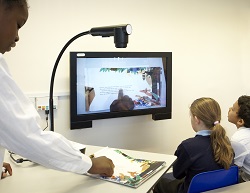- Project the words to a song and ask the children to annotate during discussion of the meaning.
Music lessons at KS3 and KS4
- Record students’ performances, play back and give feedback.
- Give a live demonstration on a keyboard to show how to play scales and chords.
- Demonstrate how to tune an instrument.
Art and crafts lessons at KS1 and KS2
- Ask the children to add contributions to a mood board. Or make a collage and take snap shots as items are added.
- Students can closely observe intricate techniques such as moulding clay and making perfect brush strokes.
- Use the snap shot feature to create a time-lapse photography project.
- Let the children create a puppet show and video it.
Art and design lessons at KS3 and KS4
- Create simple stop motion animation films by using the freeze frame option.
- Demonstrate paint mixing and art techniques.
- Examine the properties of different types of fabrics or other materials.
- Use a split screen function to always keep workshop safety rules up while using for other purposes.
- Demonstrate needlework techniques and record how to create different effects, and then leave playing in a loop.
- Project images for composition work that can be captured and re-arranged using an interactive whiteboard.
- Zoom in to show the different parts, icons and uses of a digital camera.
- Demonstrate how to perform origami.
This list is not exhaustive and we would be delighted to hear of other ways that teachers have used a visualiser to enhance the teaching across any creative subject. If you know of any more innovative techniques that you might have applied in your classroom or other learning spaces, please share it with us in the comments section below.


















